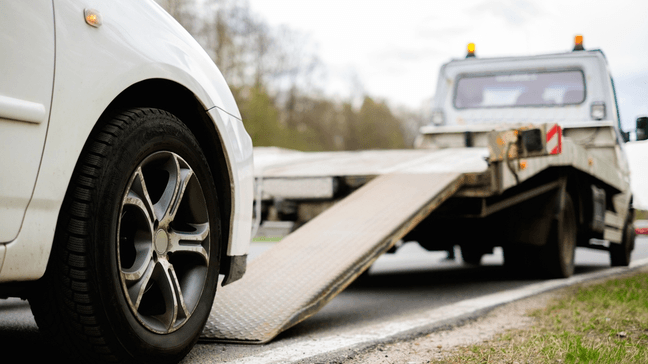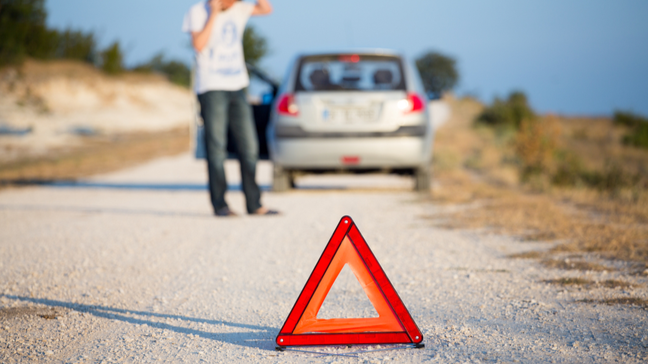As you’re shopping for car insurance quotes, you’ll notice that most providers will offer you roadside assistance.
It’s a simple question that’s hard to answer because what they’re really asking is:
Hey, do you think you’ll find yourself stranded a lot this year?
Roadside assistance is a tricky form of insurance that may be absolutely worth it for some and passable for others. To help you decide which camp you fall into, let’s investigate roadside assistance.
What is roadside assistance?

As the name implies, roadside assistance is an optional program that lets you call a 911-like hotline for your stranded car. Here’s how it works:
- You purchase a year of roadside assistance (typically between $70 and $150).
- You receive a Member ID and a hotline phone number.
- When your car is immobilized for some reason (breakdown, locked out), you call the number on the card, give your Member ID, and describe your issue.
- Dispatch sends the nearest participating mobile mechanic to your location within the hour (sometimes).
- You’re back on the road, and your roadside assistance provider comps the mechanic.
Breakdowns, getting stuck in mud or snow, running out of fuel, and simply locking yourself out are all common reasons why you might call for roadside assistance. If the mobile mechanic can’t fix your issue onsite, they’ll tow it to the nearest participating service station.
While roadside assistance is designed to get you back on the road, not every service is included. I’ll go into more detail below, but I wanted to set that expectation early on; folks are often surprised when they call for roadside assistance and still receive a bill later on.
To avoid such unpleasant surprises, let’s cover in detail what roadside assistance does and doesn’t cover.
What does roadside assistance include?
Again, roadside assistance will perform pretty much any necessary service to get your car back on the road, whether onsite or at a local garage. However, not all of it is free.
Here’s a list of services that are typically included in a roadside assistance program at no extra charge:
- Tire changes. Hey, no shame in calling for a tire change if you’re stuck on the side of the road; especially if your car is at an unsafe angle to the road. Note that the mobile mechanic will typically use your spare tire, which you should never drive on longer than 50 miles.
- Battery jump-start. Car batteries typically die within two and a half months of a car not being driven. Luckily, most roadside assistance programs cover jump starts for free.
- Fuel delivery. If you’re like my dad and think that the Low Fuel Light “really means there’s plenty left,” you’ve probably run out of gas at some point. Thankfully, roadside assistance will deliver enough fuel to get to the next gas station at no charge (you just have to cover the cost of the fuel).
- Lockout services. Lock yourself out? Roadside assistance will dispatch a locksmith to get you right back into your car in no time. Don’t be distressed if they bend your window back in lieu of picking the lock Mission Impossible-style – auto glass is surprisingly flexible, so that’s just the easiest way to do it.
- Extrication and towing (up to a few miles). Roadside assistance programs typically include free extrication (i.e. wenching you out of a ditch) and limited towing, often three to five miles per call. Sometimes your annual membership will include a pool of towing miles, like 25 for the year. Anything beyond that and you foot the bill.
That covers the services that are included in your roadside assistance program. Now, let’s talk about some that aren’t.
What does roadside assistance not include?
Sadly, roadside assistance isn’t “get your car up and running again at any cost” insurance. It’s really just a subscription to a dispatch service that won’t charge you for the quick and easy stuff, like tire changes or fuel delivery.
Roadside assistance will always show up, but you’ll have to pay extra if they need to perform services like these:
- Tire repair. If you don’t have a spare tire in the trunk, roadside assistance will have to repair or change out your existing tire – both of which usually involve towing it to a tire shop.
- Roadside diagnosis. If you have a Check Engine Light (CEL), your roadside assistance will have to use an OBD-II Scanner to read and translate your engine error codes. Most mechanics charge at least $50 for OBD-II scans, which is why I recommend all drivers buy their own scanner for $50 or less.
- Dents, dings, and scratches. Did you know that you can fix a dent in your car in about 15 seconds using only hot water and a plunger? I wish roadside assistance programs would capitalize on this for some easy brownie points with customers, but sadly, none that I know of do any sort of aesthetic repair.
- Long-distance towing. It’s worth mentioning again that most roadside assistance programs only include a few miles of towing, either per call or per year. Plus, there may be a rule stating that they can only tow you to a shop approved by your roadside assistance program, which may be on the other side of town.
- Any necessary repairs. Typically, by the time your car reaches the shop for repairs, you’re totally on your own for the cost of repairs. AAA and State Farm are the exception to this rule: AAA will cover 10% of the final bill and State Farm will cover the first hour of labor – that’s around $100 if you drive a Toyota and $200 if you’re in a Porsche.
Should you buy roadside assistance from your auto insurance provider, AAA, or someone else?

Most people think “AAA” when they hear “roadside assistance” and for good reason. The American Automobile Association has been around since 1902, six years before the Ford Model T even began production.
With over a century of experience protecting American motorists, AAA is hard to beat. That said, others are certainly trying; in recent years, most of the major auto insurance providers have stepped in to chip away at AAA’s market dominance.
So what does one have to offer over the other?
Roadside assistance from AAA
AAA is the Toyota Camry of roadside assistance: affordable, dependable, and well-equipped. The AAA Basic Membership costs around $60 – $100 annually depending on your region, and includes the following roadside benefits.
- Four free service calls per member per year.
- Three to five free towing miles per call (depends on your region).
- Free fuel delivery.
- Free extrication.
- Up to $50 per year in locksmithing services.
Now, you might be thinking that’s not a whole lot of coverage. Honestly, I agree with you; $50 of locksmithing services can dry up in a single call, and three miles of towing isn’t particularly far, especially if you live in a rural area. These are certainly the two weakest points in AAA’s armor, and the ones competitors are targeting.
However, AAA still has the competition walloped in two key areas:
- Perks and benefits. 119 years of networking has certainly paid off; AAA offers huge discounts with a bevy of retailers, many of whom aren’t even auto-related. Included in your AAA membership is up to 30% off at Samsung, The UPS Store, HP, rental car agencies, and more. You’ll also get 10% off at Dell, which if you’re buying a $1,500 laptop, pays for two years of AAA itself.
- Free Associate Membership. Included in your AAA membership is one free Associate Membership for a member of your household. Associate AAA members enjoy the same benefits as you either for free or at a steeply discounted rate, so it’s like a roadside BOGO.
Like a Camry, AAA membership is popular for a reason – but that doesn’t mean it’s necessarily the best option for you. It’s entirely possible that your provider has them beat.
Roadside assistance from your auto insurance provider
Don’t assume that the roadside assistance program your provider offers will directly mimic AAA’s like a generic brand cereal. Providers can’t possibly match AAA’s affiliate perks and benefits, so they compete on roadside coverage instead.
Even still, most providers can’t offer increased coverage across the board – they generally offer a little more here and a little less there.
For example, Allstate can’t offer 30% off a new fridge at Samsung.com, but they do include $1,500 in complimentary Trip Interruption coverage with their roadside assistance program. That means if you miss your expensive trip due to illness or tragedy, your Allstate roadside assistance coverage will comp you up to $1,500, even if driving wasn’t involved.
Allstate also includes $100 in Roadside Hazard coverage, which helps to cover the cost of a tire repair (~$15) or a new tire ($80 – $200) after you hit a road hazard. If you live in a pothole moonscape like LA or Boston, free tire replacement could be a seriously useful perk.
Allstate’s roadside assistance program isn’t a holistic upgrade from AAA’s, however – you lose those affiliate discounts, the associate membership, and you’re only given three calls per year compared to AAA’s four.
The subtle differences between Allstate and AAA’s coverage serve to highlight why you should read the terms of your own provider’s roadside assistance program extremely carefully. Providers tend to bury the areas where they can’t beat AAA, so bring a magnifying glass.
Are there any alternatives?
AAA and your provider aren’t the only two players vying for roadside dominance.
Better World Club is a direct response to AAA and they’re certainly not shy about why they’re trying to topple the industry stalwart. In stark contrast to AAA, they say, BWC is 100% carbon-neutral, supports environmental causes, and advocates for sustainable transportation.
Although they price-match AAA on membership and coverage, they’re short on perks, discounts, and that extra associate membership. Still, if you’d prefer roadside assistance from a more eco-conscious, forward-thinking company than AAA, consider Better World Club.
Is paying for roadside assistance worth it?

Whether or not roadside assistance is worth it depends on a few factors. To keep things simple, I’ll break it down into two categories:
You might consider paying for roadside assistance if:
If you meet one or more of the following criteria, it might be worth ponying up for roadside assistance.
- You find yourself stranded at least once a year. Emergency roadside assistance calls typically cost $99 a pop, so if you sense that you might be stranded at some point in the next year, a membership could pay for itself very quickly.
- You drive in a city with inclement weather. AAA membership is typically more expensive in cities up north and for good reason; the likelihood that you’ll need to be winched out of a snowbank is much higher above the Mason-Dixon Line. Plus, getting stranded in cold weather can be life-threatening, so roadside assistance is practically a no-brainer.
- Your car is prone to breakdowns. Is your car old? Unreliable? Behind on maintenance? Roadside assistance providers don’t charge extra for cars that are more likely to break down, so if you don’t always trust your ride to start up, it’s probably worth the extra insurance.
- You drive more than 20,000 miles a year. Simply put, the more miles you drive, the higher the likelihood you’ll need roadside assistance at some point.
- You want peace of mind. Even when they don’t use it, folks seldom regret having roadside assistance coverage. For the average motorist, just having a AAA card in their glove compartment can be a huge stress-reliever.
If you identified with one or more of the above qualifiers, it’s probably worth the $100 or so for roadside assistance coverage. That said, you might still be fine without it.
You can probably pass on roadside assistance if:
If you really want to save the $100, you can probably safely pass on roadside assistance if:
- You drive a reliable car. If you drive a historically reliable car that’s unlikely to leave you stranded due to a mechanical issue, that’s one less reason to buy roadside assistance.
- You rarely drive in inclement weather. Similarly, if Mother Nature is unlikely to leave you stranded on your usual commute, you’re way less likely to need an emergency extrication.
- You rarely drive at all. If you barely drive your car, you’re significantly less likely to get stranded and thus probably don’t need roadside assistance. If you’re worried about your battery dying, don’t pay $100 for roadside – just spend $30 on a battery maintainer that charges your car from a standard wall socket.
Summary
Roadside assistance can lend convenience, peace of mind, even safety to your daily driving experience. $100 or less isn’t much to pay for free towing, jump starts, and lockouts, and the extra bonuses like trip insurance and hazard protection often make it totally worth it.
Even still, if you don’t foresee yourself being stranded anytime soon, you’re probably OK without it. Invest $80 or so bucks in an OBD-II scanner and battery maintainer and you’ll be much more self-sufficient at staying on the road.